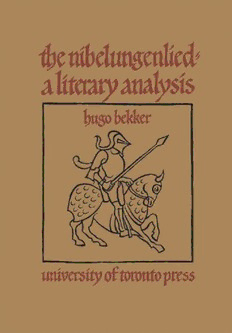
The Nibelungenlied: A Literary Analysis PDF
Preview The Nibelungenlied: A Literary Analysis
The Nibelungenlied: A Literary Analysis HUGO BEKKER In the last fifty or so years there has been a gradual shift of attention in scholarship on the Nibelungenlied from reconstruction of the texts, and tracing of the poem's multiple and complex antecedents, to interpretation. In spite of this trend, there is still a pressing need for a critical analysis of the Nibelungenlied as a whole that draws together its various literary qualities and examines in detail the epic's unity, depth, and meaning. Professor Bekker's study provides this kind of analysis. It takes a fresh approach, viewing the poem as a work of literary merit worthy to be read for its own sake. It traces the new designs which the poet brings to the tradition and provides detailed examinations of the main aspects of technique and structure in the epic. The approach is based on close consultation of the text, with little digression, in an attempt to guide the reader to an understanding and appreciation of the poem as the author intended it to be read. Professor Bekker points out that the poet of the Nibelungenlied does not aim at psychological character delineation and deliberately refrains from seeking to establish the various prominent figures in the epic as individuals in the modern sense of the term. Instead, they emerge as representative figures whose interrelationships, though interesting, are less important for the unity and meaning of the epic than are their common relationships to the world in which they exist. The question of personal guilt or innocence becomes irrelevant, and Professor Bekker sees the work ultimately as a poetic pageant of a noble way of life and its destruction. Symbolism, imagery, parallelism, symmetry, and other structural devices all contribute to the design which expresses the nature of this noble life, and Professor Bekker's book is a valuable guide to the complex architecture of this thirteenth-century masterpiece. HUGO BEKKER was born in Burgh, The Netherlands, in 1925. He studied at the University of Michigan, receiving his PHD in 1958, and taught at the University of Oregon for the next three years. He is at present Professor of German, Ohio State University. This page intentionally left blank the nibelungenlied" a literary analysis university of toronto press © University of Toronto Press 1971 Printed in Canada by University of Toronto Press Toronto and Buffalo ISBN 0-8020-5235-5 FOR ELIZABETH This page intentionally left blank ACKNOWLEDGMENTS BY KIND PERMISSION of the editors of the Germanic Review, "King- ship in the 'Nibelungenlied,'" GR, XLI (1966), 251-63, and "The Eigenmann-Motif in the 'Nibelungenlied,' " GR, XLII (1967), 5-15, are incorporated into this volume in the studies on Brunhild. Endeavors have been made to hone the pertinent arguments presented in those articles, and to add desirable notes on literary criticism of the Brunhild figure. The manuscript of this book was finished when Mowatt and Sacker's The Nibelungenlied: An Interpretative Commentary appeared. Because it seemed desirable to relate their work to this, various notes have been inserted to present interpretations advanced by the Com- mentary's authors. Whereas the present work might benefit from tak- ing portions of Mowatt and Sacker's introduction as its own, there are differences - some basic - between the Commentary proper and the suggestions presented in the following pages. Hence most of the citations have been allowed to stand by themselves to give the reader the opportunity to draw his own conclusions about divergent views. I wish to express my debt of gratitude to the late W. Robert Jones for going over the manuscript and cleansing it of stylistic impurities. This volume was published with the aid of the Publications Fund of the University of Toronto Press. This page intentionally left blank CONTENTS Introduction xi I Gems, clothes, festivities 3 II Huns and Burgundians 24 III Kriemhild 50 IV Brunhild: the kingship motif 69 v Brunhild: the Eigenmann motif 84 VI Siegfried 101 VII Hagen in relation to Siegfried 118 VIII Hagen in relation to minor characters 135 IX Conclusion: structural devices and their consequences 149 Abbreviations 166 Bibliography 167 Index 173
